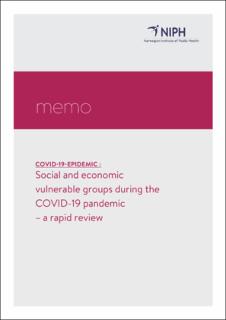| dc.description.abstract | Key message
This rapid review is mainly based on searching the Norwegian Institute of Public Health’s systematic living map on COVID-19 related evidence. One author assessed the relevance of each reference based on titles and abstracts. Both Authors’ included studies based on full-text examinations and summarized the findings. We did not perform a formal quality assessment of included studies, nor did we grade the certainty of evidence. Results should be interpreted with caution. In the current situation, there is an urgent need for identifying the most important evidence quickly. Hence, we opted for this rapid approach despite an inherent risk of overlooking key evidence or making misguided judgements.
The aim of this rapid review is to identify any reported associations between increased severity of COVID-19 disease, and infection rates in populations postulated to be socially or economic vulnerable. We also looked for studies reporting on the effects of transmission control measures in vulnerable groups, and interventions specifically aimed at vulnerable groups. Vulnerable groups covered by this review are persons that may have socially and economic challenges including migrants/immigrants, homeless, persons with disabilities (physical or mental), persons with dementia, incarcerated persons, persons with psychological or psychiatric disorders, and persons with problematic substance or alcohol use.
We identified 434 titles from which 117 were included in full text. Based on full-text examinations, one systematic review and 32 primary studies were included. Except for one Swedish study of COVID-19 associated death rates and a global model on infection rates, we found no studies reporting data from a Scandinavian country.
We identified seven studies, including the Swedish study, suggestive of low income, poverty, living in deprived areas, and certain ethnic backgrounds to be associated with an increased risk of COVID-19 related death compared to the general population. Furthermore, poor people (one model study), incarcerated persons (two studies) and homeless persons in shelters (three studies) may have an increased risk of SARS-CoV-2 infection or COVID-19 disease compared to the general population.
We found evidence from two studies that persons with mental illness had fewer admissions to psychiatric hospital wards during the pandemic. In contrast to this, there is evidence of higher vulnerability with regard to anxiety, depression and stress in persons with psychiatric disorders. We found single studies of MS patients, Parkinson patients, and parents of children with autism spectre disorder and parents of children with ADHD that reported anxiety, and mood to be negatively affected by the pandemic.
We found almost no research-based evidence (so far) of health related effects of interventions aimed to support socially or economic vulnerable groups exposed to the COVID-19 pandemic or transmission control measures.
In conclusion, there is very little research-based evidence related to socially and economic vulnerable groups during the COVID-19 pandemic and the transferability of finding to the Norwegian context is limited. | |
